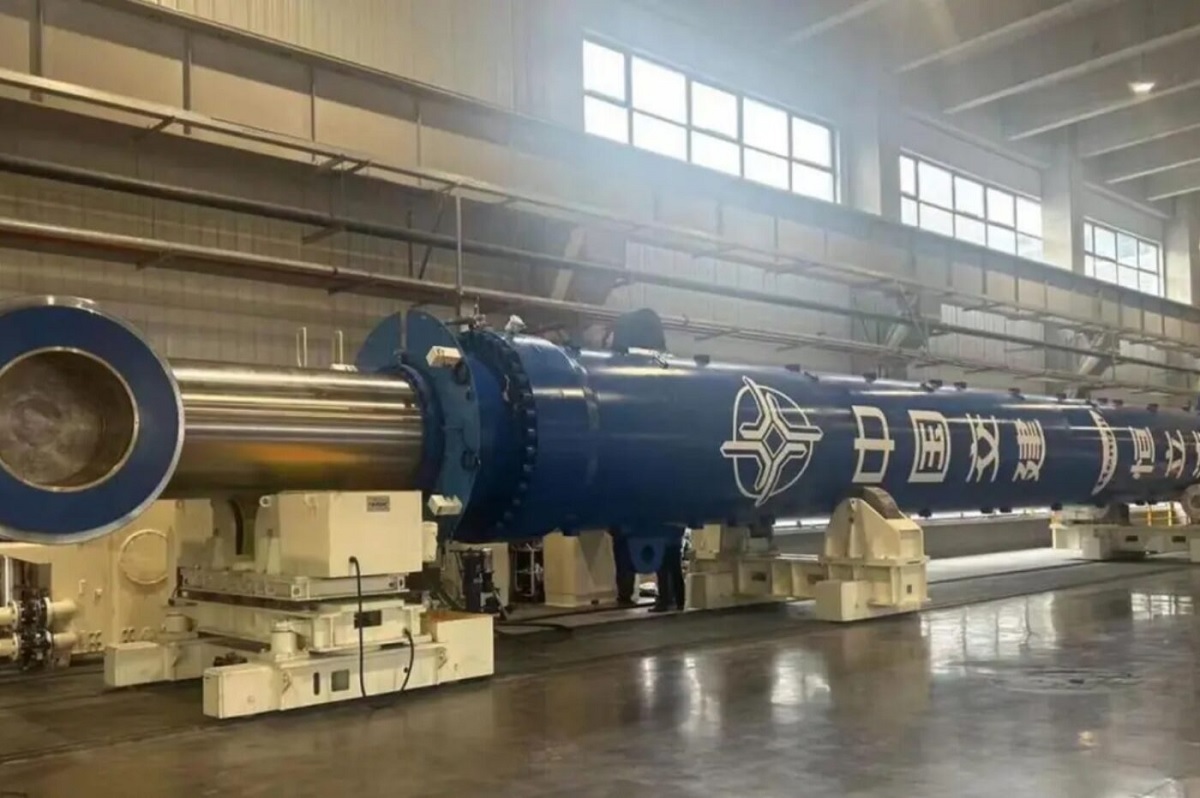The rise of a hydraulic powerhouse
In Changzhou, China has unveiled a hydraulic behemoth capable of exerting roughly 5,000 tons of force, the weight of more than 1,000 elephants. The device is a 28‑meter tall, 2‑meter wide cylinder built for ultra‑heavy maritime operations.
Designed by China Communications Construction Company (CCCC), the unit will anchor a 150‑meter offshore drilling vessel now under construction. Its mission is to drive piles for bridges and platforms, enabling deepwater projects once out of reach.
Engineering built for scale
The cylinder’s towering dimensions rival a ten‑story building, yet its performance rests on precision. High‑force actuation demands tight tolerances, resilient seals, and robust controls that can withstand violent marine loads.
Such machinery must tame fatigue, resist saltwater corrosion, and deliver repeatable strokes under punishing cycles. In this regime, the difference between efficiency and failure is measured in microns and megapascals.
From import dependence to industrial autonomy
Until recently, China often sourced similar equipment from abroad, relying on established suppliers for critical components. This breakthrough signals a confident pivot toward domestic capability across the marine and infrastructure sectors.
Strategic self‑reliance aligns with mega‑projects like the Hangzhou Bay rail crossing, envisioned as the world’s longest sea‑spanning bridge. A local supply chain promises faster iterations and lower risk amid global frictions.
A catalyst for offshore wind
Beyond bridges, the cylinder unlocks deployment of offshore wind assets in increasingly challenging waters. Taller turbines and deeper foundations require reliable force on demand and safe, precise control in rough seas.
As arrays move farther from shore, installation margins shrink and downtime grows costlier. Heavy‑lift hydraulics, paired with smart monitoring, can compress schedules and boost capacity factors across entire wind farms.
Market dynamics and competitors
The global hydraulics market surpassed $15 billion in 2023, with a projected near‑5% annual growth rate. Players like Bosch Rexroth and Parker Hannifin dominate, but new Chinese entrants are narrowing the gap.
Competition now centers on system integration, digital diagnostics, and lifecycle service. Whoever masters high‑force reliability at scale will set the pace in offshore infrastructure for the decade ahead.
Systems beyond the cylinder
CCCC’s advance dovetails with broader Chinese innovation, such as SANY’s facility that compresses two decades of wind‑farm wear into a single year. Accelerated testing speeds learning loops and reveals failure modes before field deployment.
Such platforms shorten development cycles and reduce operational risk for turbines pushing into the 30‑plus megawatt class. When coupled with indigenous fabrication, they form a potent engine for export growth.
What this enables
- Faster installation of deepwater foundations, with fewer weather‑related delays
- Greater control over project timelines, lowering financing and logistics risk
- Reduced reliance on imports, strengthening domestic know‑how
- Better utilization of heavy vessels, improving overall fleet economics
Economic signals from the sea
China’s maritime economy expanded to roughly 4.9 trillion yuan in early 2024, about $679 billion equivalent. Growth outpacing national GDP underscores the sector’s role as a strategic pillar for investment and jobs.
As port upgrades, energy hubs, and subsea cables proliferate, heavy hydraulics become quiet enablers of state ambition. Behind landmark structures, these cylinders deliver invisible, repeatable force.
Control, safety, and data
Modern hydraulic systems rely on sensors and closed‑loop control to maintain safe, accurate strokes. Predictive analytics flags leaks, pressure anomalies, or seal wear long before catastrophic failures.
Digital twins and onboard telemetry can simulate mission profiles and validate procedures in advance. That translates into safer crews, fewer incidents, and higher asset availability offshore.
Global implications
Growing maritime strength carries geopolitical weight, especially amid contested supply chains. Proprietary capabilities in heavy infrastructure can translate into influence along key trade corridors.
“Scaling heavy‑force precision at sea is about more than machinery; it’s about control over the next generation of infrastructure,” said one senior engineer familiar with offshore platforms.
Challenges that remain
Marine environments are unforgiving, and sustaining 5,000‑ton loads requires relentless quality assurance. Long‑term reliability hinges on seal chemistry, surface finishes, and disciplined maintenance regimes.
Spare‑parts logistics and specialized talent remain chokepoints, particularly when projects span vast distances. Building a durable service network will be essential to capture lifetime value.
The bigger picture
What looks like a single cylinder is better seen as a system of systems: materials, controls, vessels, and crews. Together they compress time, expand feasible depths, and open new corridors for energy and transport.
As deployments accelerate, expect rapid iterations, tighter standards, and more transparent metrics. The winners will pair brute force with finesse, making precision the ultimate competitive edge.
From metaphor to momentum
Lifting 1,000 elephants is a striking metaphor, but the real story is momentum in industrial capability. With every sea pile driven, a quieter transformation in engineering takes hold.
If the past decade forged capacity, the next will test resilience and global reach. On that front, this towering cylinder signals intent—and a new chapter for offshore ambition.

